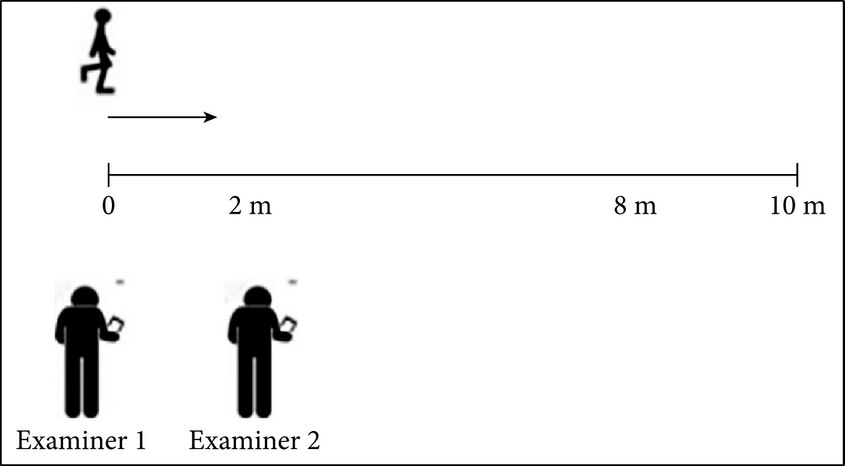Functional Walking Test (FWT): Difference between revisions
Aya Alhindi (talk | contribs) No edit summary Tags: Reverted Visual edit |
Aya Alhindi (talk | contribs) mNo edit summary Tags: Reverted Visual edit |
||
| Line 7: | Line 7: | ||
== Introduction == | == Introduction == | ||
[[File:Child tiptoes.jpg|right|frameless|250x250px]] | [[File:Child tiptoes.jpg|right|frameless|250x250px]] | ||
The Functional Walking Test (FWT) is a clinical | The Functional Walking Test (FWT) also known as The 6-minute walk test (6MWT) is a submaximal exercise test designed to assess clinical populations' functional exercise capacity. It measures the distance walked in six minutes. | ||
Because of characteristics such as growth stage and age, obtaining reference values in the paediatric population is especially difficult so it would be useful to assess children with neurological or musculoskeletal conditions that affect their ability to walk.<ref name=":1">Mylius, C. F., Paap, D., & Takken, T. (2016). Reference value for the 6-minute walk test in children and adolescents: a systematic review. ''Expert Review of Respiratory Medicine'', ''10''(12), 1335–1352. <nowiki>https://doi.org/10.1080/17476348.2016.1258305</nowiki></ref> | |||
The FWT consists of several components, including: | The FWT consists of several components, including: | ||
Revision as of 15:48, 5 July 2023
Original Editor - Kapil Narale
Top Contributors - Kapil Narale, Aya Alhindi and Kim Jackson
Introduction[edit | edit source]
The Functional Walking Test (FWT) also known as The 6-minute walk test (6MWT) is a submaximal exercise test designed to assess clinical populations' functional exercise capacity. It measures the distance walked in six minutes.
Because of characteristics such as growth stage and age, obtaining reference values in the paediatric population is especially difficult so it would be useful to assess children with neurological or musculoskeletal conditions that affect their ability to walk.[1]
The FWT consists of several components, including:
- Walking 10 meters
- Ascending and descending a step
- Walking on tiptoes and heels.
The child is timed during each task, and the results are used to assess their functional mobility.A 'functional walk' can be classified as the ability to stop, start, turn, and get into a position. [2]
The FWT is a reliable and valid assessment tool that has been used in several studies to evaluate children with various conditions, including cerebral palsy, muscular dystrophy, and spina bifida. It can be used to assess changes in a child's mobility over time and to evaluate the effectiveness of interventions.[1]
Development of the Functional Walking Test[edit | edit source]
The Functional Walking Test (FWT) was developed by K. Barry and J. Hussey in 2004 as a modification of the 6-Minute Walk Test (6MWT), which was originally developed for adults. The FWT was specifically designed for use in children with neurological or musculoskeletal conditions that affect their ability to walk.[3]
Method of use[edit | edit source]
Equipment Required:
- Stopwatch or timer
- Tape measure
- Step: A step that is approximately 15 cm (6 inches) high is needed for the second task of ascending and descending a step.
- Assisted devices: Assisted devices such as walkers, crutches or canes may be required for some children during the test.
Set-Up:
- Open space that is at least 10 meters (33 feet) long.
- Flat surface and no obstacles.
Patient Instructions:
- During the FWT, the child is instructed to walk 10 meters (33 feet) as quickly and safely as possible, with or without an assistive device if needed. The child's time is measured using a stopwatch, starting when the child's foot crosses the starting line and stopping when the child's foot crosses the finish line.
- After completing the 10-meter walk, the child is asked to ascend and descend a step that is approximately 15 cm (6 inches) high. The child's time is measured using a stopwatch, starting when the child's foot touches the first step and stopping when the child's foot touches the ground on the other side.
- Next, the child is asked to walk on their tiptoes for 10 meters (33 feet). The child's time is measured using a stopwatch, starting when the child's foot crosses the starting line and stopping when the child's heel touches the ground.
- Finally, the child is asked to walk on their heels for 10 meters (33 feet). The child's time is measured using a stopwatch, starting when the child's foot crosses the starting line and stopping when the child's toes touch the ground.[3]
Functional Walking Test (FWT) and the International Classification of Functioning, Disability, and Health (ICF)[edit | edit source]
- The FWT was designed to be a quick and simple assessment of functional walking ability. This is classified to fit within the 'activity' category of the International Classification of Functioning, Disability, and Health (ICF). It's specific purpose is to assess physical function and balance associated with gait, without targeting any other areas of gross motor function. [2]
- It does not address any other aspects of the ICF, such as, Bodily Structure and Function, or Participation. [2]
- When a more holistic profile of a child is needed, the FWT can be administered with other measure or tests, which address the other respective aspects of the ICF. [2]
Reliability and Validity[edit | edit source]
The FWT has been shown to be a reliable and valid assessment tool for measuring functional mobility in children with various neurological or musculoskeletal conditions. One study evaluated the reliability of the FWT in children with cerebral palsy and found high intra-rater and inter-rater reliability, with intraclass correlation coefficients (ICCs) ranging from 0.96 to 0.98. [4]
Another study found that the FWT had good concurrent validity when compared to the 6-minute walk test in children with spina bifida.[4]
In addition, the FWT has been shown to be sensitive to changes in walking ability over time, and can be used to monitor the effects of different interventions on functional mobility in children with cerebral palsy. One study found that changes in FWT scores correlated with changes in walking speed and gross motor function in children with cerebral palsy.
Overall, the FWT is a reliable and valid tool for assessing functional mobility in children with neurological or musculoskeletal conditions.
References[edit | edit source]
- ↑ 1.0 1.1 Mylius, C. F., Paap, D., & Takken, T. (2016). Reference value for the 6-minute walk test in children and adolescents: a systematic review. Expert Review of Respiratory Medicine, 10(12), 1335–1352. https://doi.org/10.1080/17476348.2016.1258305
- ↑ 2.0 2.1 2.2 2.3 Quinn Aoife, O'Regan Myra, Horgan Frances. Psychometric evaluation of the functional walking test for children with cerebral palsy. Disability and Rehabilitation. 2011:33(25–26): 2397–2403.
- ↑ 3.0 3.1 Barry K, Hussey J. Development of the Functional Walking Test for children with cerebral palsy. J Pediatr Orthop. 2004;24(2):215-8. doi: 10.1097/01241398-200403000-00020. PMID: 15076585.
- ↑ 4.0 4.1 Ko J, Kim M, Hwang J, Kim Y, Kim Y, Lee S. Validity and reliability of the functional walking test for children with cerebral palsy. Disabil Rehabil. 2020;42(1):123-128. doi: 10.1080/09638288.2018.1533264. Epub 2018 Nov 6. PMID: 30398044.








